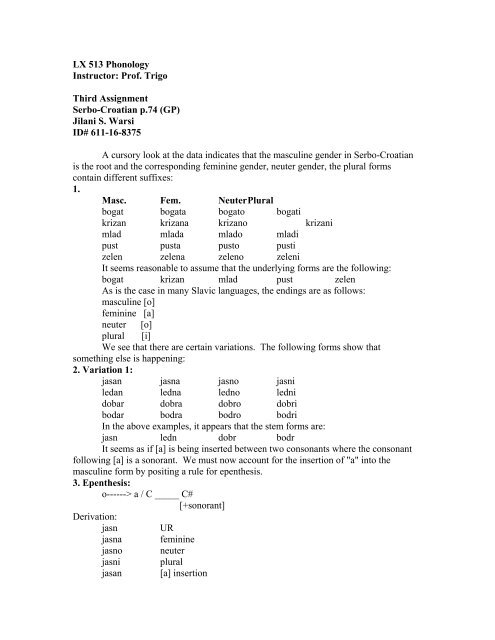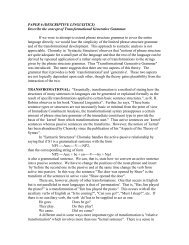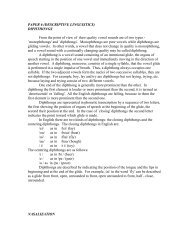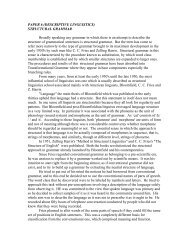LX 513 Phonology - Jilani S. Warsi
LX 513 Phonology - Jilani S. Warsi
LX 513 Phonology - Jilani S. Warsi
You also want an ePaper? Increase the reach of your titles
YUMPU automatically turns print PDFs into web optimized ePapers that Google loves.
<strong>LX</strong> <strong>513</strong> <strong>Phonology</strong><br />
Instructor: Prof. Trigo<br />
Third Assignment<br />
Serbo-Croatian p.74 (GP)<br />
<strong>Jilani</strong> S. <strong>Warsi</strong><br />
ID# 611-16-8375<br />
A cursory look at the data indicates that the masculine gender in Serbo-Croatian<br />
is the root and the corresponding feminine gender, neuter gender, the plural forms<br />
contain different suffixes:<br />
1.<br />
Masc. Fem. Neuter Plural<br />
bogat bogata bogato bogati<br />
krizan krizana krizano krizani<br />
mlad mlada mlado mladi<br />
pust pusta pusto pusti<br />
zelen zelena zeleno zeleni<br />
It seems reasonable to assume that the underlying forms are the following:<br />
bogat krizan mlad pust zelen<br />
As is the case in many Slavic languages, the endings are as follows:<br />
masculine [o]<br />
feminine [a]<br />
neuter [o]<br />
plural [i]<br />
We see that there are certain variations. The following forms show that<br />
something else is happening:<br />
2. Variation 1:<br />
jasan jasna jasno jasni<br />
ledan ledna ledno ledni<br />
dobar dobra dobro dobri<br />
bodar bodra bodro bodri<br />
In the above examples, it appears that the stem forms are:<br />
jasn ledn dobr bodr<br />
It seems as if [a] is being inserted between two consonants where the consonant<br />
following [a] is a sonorant. We must now account for the insertion of "a" into the<br />
masculine form by positing a rule for epenthesis.<br />
3. Epenthesis:<br />
o------> a / C _____ C#<br />
[+sonorant]<br />
Derivation:<br />
jasn UR<br />
jasna feminine<br />
jasno neuter<br />
jasni plural<br />
jasan [a] insertion
There is one example, however, that causes problem to our epenthesis rule. We<br />
stated that [a] is inserted root-finally between two consonants. As we can see, this<br />
doesn't happen in the following case:<br />
4. Variation 2:<br />
mukao mukla muklo mukli<br />
Remembering the previous observations, we can conclude that the stem form is<br />
'mukl', and [a] is inserted between the two consonants, satisfying the epenthesis rule. The<br />
following data support our assumption:<br />
beo bela belo beli<br />
mio mila milo mili<br />
veseo vesela veselo veseli<br />
ustao ustala ustalo ustali<br />
Apparently, [l] is becoming [o] in these cases here. This will be the vocalization<br />
rule:<br />
5. Vocalization:<br />
[l] --------> [o] / _______ #<br />
Following the pattern established so far, we can assume that the masculine forms<br />
are:<br />
beo mio veseo ustao<br />
We need to state now in what order these rules are operating:<br />
6. Rule Ordering:<br />
I. mukl Stem<br />
II. mukal Epenthesis ([a] is inserted)<br />
III. mukao Vocalization ([l] is becoming [o])<br />
Application of the various endings gives us:<br />
mukao mukla muklo mukli<br />
This seems appropriate because if we reverse the rule ordering-vocalization<br />
before epenthesis-it would result in ungrammatical forms.<br />
Now that we have discussed segmental alternations, we need to discuss the<br />
location of the accent. If we look at the data carefully, it becomes clear that the accent<br />
generally falls on the rightmost vowel of the word. The following data strengthens our<br />
assumption:<br />
7. Accent Placement:<br />
mlad mlada<br />
pust pusta<br />
bel bela<br />
mil mila<br />
zelen zelena<br />
jasn jasna<br />
dobr dobra<br />
mukl mukla<br />
Based on the data, we need to posit a rule for accent placement.<br />
8. Accent Placement Rule:<br />
V -----> V where V is the rightmost vowel of the word.<br />
We need to specify the sequence of rules. It is reasonable to assume that the<br />
accent placement rule operates before epenthesis and vocalization. It follows that in
proposing rules, we should explain only the possible grammatical forms. If we reverse<br />
the rule ordering, i.e. apply epenthesis before the accent placement rule, we will get<br />
ungrammatical forms.<br />
9. Rule Ordering:<br />
mukl Stem<br />
mukl mukla Accent Placement<br />
mukal mukla Epenthesis<br />
mukao mukla Vocalization<br />
10. Verbs:<br />
We have already determined the suffixes to be o, a, and respectively. Now we<br />
need to pinpoint the past and 1st singular present endings:<br />
1 sg. Pres Past-Masc. Past-Fem Past-Neut<br />
tepem tepao tepla teplo<br />
skublem skubao skubla skublo<br />
tresem tresao tresla treslo<br />
vezem vezao vezla vezlo<br />
pecem pekao pekla peklo<br />
zezem zegao zegla zeglo<br />
Underlying forms:<br />
tepao skubao tresao vezao pekao zegao<br />
Suffixes:<br />
The data show that the 1st singular present suffix is -em, and the past morpheme<br />
is -l. On the surface, the past-masculine appears to be contradicting our assumption. But<br />
our vocalization rule seems to be at work in this particular case. We stated earlier that l<br />
becomes o when followed by #. This accounts for the fact that the past morpheme has an<br />
-o ending.<br />
Some other verbs such as 'kradem', 'pletem', 'metem', and 'vedem' indicate that our<br />
rule ordering is not accurate. That is to say, we need an additional rule to account for the<br />
following:<br />
kradem kralo krala kralo<br />
pletem plelo plela plelo<br />
metem mel mela melo<br />
vedem vel vela velo<br />
A close scrutiny of the data reveals that another rule is deleting [t] or [d] before an<br />
[l]. We will call this rule coronal deletion rule.<br />
11. Coronal Deletion:<br />
[t/d] -----> o / _________ [l]<br />
To derive the forms listed above, we must order the rule as follows:<br />
1. Accent Placement<br />
2. Coronal Deletion<br />
3. Epenthesis<br />
4. Vocalization<br />
The motivation for ordering rules in this way comes from the fact that if we apply<br />
the epenthesis rule before coronal deletion, we get ungrammatical forms. For example, if<br />
we apply epenthesis rule first, we will get forms such as 'pletal', kratal', metal', etc.<br />
because vocalization has not taken place yet under this wrong assumption. Therefore, it
must be the case that the coronal consonants [t/d] are deleted first to prevent the<br />
derivation of ungrammatical forms. Also, in this particular case, epenthesis cannot take<br />
place after coronal deletion because the requirements for epenthesis are not fulfilled;<br />
there must be two consonants for epenthesis to occur.<br />
12. Deviation<br />
Data:<br />
pacem pekao pekla peklo<br />
zezem zegao zegla zeglo<br />
Underlying forms:<br />
peg<br />
zeg<br />
13. Palatalization:<br />
We now must account for the k ~ c and g ~ z alternations:<br />
[+velar] ------> [+palatal] / ___________ e<br />
This is our palatalization rule which applies in the following way:<br />
pecem pekal pekla peklo<br />
zezem zegal zegla zeglo<br />
There is no data which gives us reason to believe that palatalization needs to be<br />
ordered with the other rules in any particular way.





